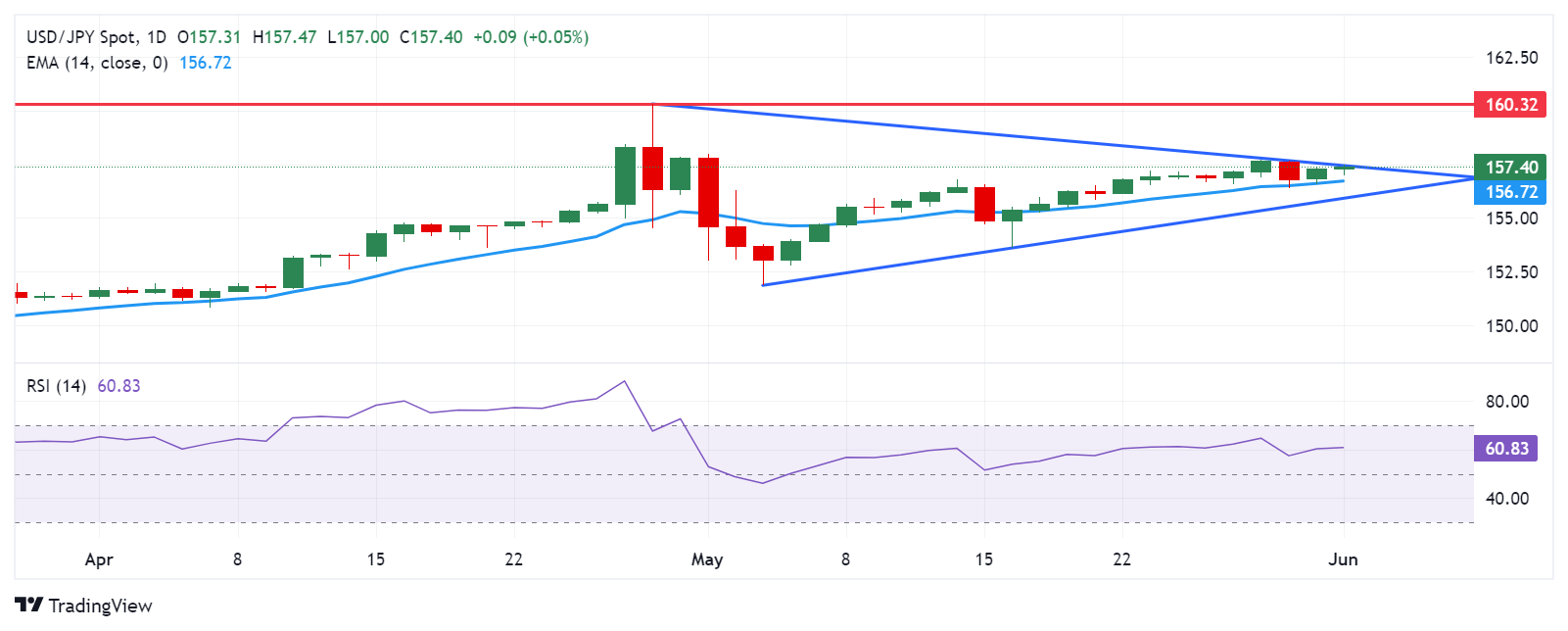- The Japanese Yen edges lower as investors adopt caution ahead of ISM Manufacturing PMI.
- The Jibun Bank Manufacturing PMI rose to 50.4 in May, indicating the first expansion since May 2023.
- The US Dollar depreciated as Fed officials suggested no further interest rate hikes.
The Japanese Yen (JPY) retraces its recent losses, with Japanese Economy Minister Yoshitaka Shindo announcing on Monday that the government will “continue efforts for primary balance to reach within surplus territory in FY 2025.” Shindo also expressed optimism, stating that “Real economic growth of 1.3% in FY 2025 is not so unrealistic,” per Reuters.
Japan's Tokyo Consumer Price Index (CPI), released on Friday, rose to 2.2% year-over-year in May, up from April's 1.8% rise. If nationwide inflation in Japan were to decline, it would likely deter the Bank of Japan (BoJ) from raising interest rates. The substantial interest rate differential between Japan and other countries continues to exert pressure on the Japanese Yen, supporting the USD/JPY pair.
US Dollar Index (DXY), which measures the value of the US Dollar (USD) against six other major currencies, lost ground after the release of the Federal Reserve's preferred US Personal Consumption Expenditure (PCE) data, showing a moderation in price pressures in April.
Last week, Federal Reserve (Fed) officials suggested that the central bank could potentially achieve its 2% annual inflation target without implementing additional interest rate hikes. This stance has led to downward pressure on US Treasury yields, weakening the Greenback. Investors will likely monitor the ISM Manufacturing PMI on Monday, seeking fresh cues on the conditions of the US economy.
Daily Digest Market Movers: Japanese Yen depreciates amid dovish BoJ official statement
- The Jibun Bank Japan Manufacturing PMI rose 50.4 month-on-month in May from April’s 49.6, indicating the first expansion in manufacturing activity since May 2023.
- Reuters reported on Monday that Bank of Japan Executive Director Takashi Kato stated that “BoJ has no plan to immediately unload its exchange-traded funds (ETF) holdings.” Kato said, “I hope to spend time examining how to unload BoJ’s ETF holdings in the future.”
- Japan’s Retail Sales (YoY) grew 2.4% in April, accelerating from a downwardly revised 1.1% rise in March and surpassing market forecasts of 1.9% growth. This marks the 26th consecutive month of expansion, indicating a sustained period of healthy consumption in Japan.
- On Friday, the US PCE Index rose 0.3% MoM and 2.7% YoY in April, matching the expectations. The Core PCE, excluding the volatile food and energy, climbed 0.2% MoM in April, lower than the expected 0.3% rise. On an annual basis, the index jumped 2.8% as expected.
- In an interview with Fox Business on Thursday, Atlanta Fed President Raphael Bostic stated that he does not think additional rate increases are necessary to achieve the Fed's 2% annual inflation target. Furthermore, New York Fed President John Williams stated that inflation is currently too high but should start to decline in the second half of 2024. Williams believes that monetary policy action is not urgently needed.
Technical Analysis: USD/JPY tests the key level of 157.50
The USD/JPY pair trades around 157.40 on Monday. Analysis of the daily chart shows a symmetrical triangle pattern, indicating a temporary pause in the prevailing bullish trend. However, the 14-day Relative Strength Index (RSI) remains above 50, suggesting a continued bullish bias for the pair.
In terms of potential price movements, the USD/JPY pair is testing the upper boundary of the symmetrical triangle, with the psychological level of 158.00 acting as the next target. A breach above this level could provide support for the pair to retest 160.32, which represents its highest level in over thirty years.
Conversely, immediate support is seen at the psychological level of 157.00, followed by the 14-day Exponential Moving Average (EMA) at 156.72. Further downward movement could lead the USD/JPY pair to navigate the area around the lower boundary of the symmetrical triangle.
USD/JPY: Daily Chart
Japanese Yen price today
The table below shows the percentage change of the Japanese Yen (JPY) against listed major currencies today. Japanese Yen was the weakest against the US Dollar.
| USD | EUR | GBP | CAD | AUD | JPY | NZD | CHF | |
| USD | 0.15% | 0.24% | 0.24% | 0.17% | -0.06% | 0.07% | 0.15% | |
| EUR | -0.15% | 0.09% | 0.10% | 0.02% | -0.20% | -0.08% | 0.01% | |
| GBP | -0.24% | -0.09% | 0.01% | -0.08% | -0.28% | -0.16% | -0.08% | |
| CAD | -0.24% | -0.12% | -0.01% | -0.08% | -0.28% | -0.17% | -0.08% | |
| AUD | -0.17% | -0.03% | 0.09% | 0.08% | -0.20% | -0.09% | 0.01% | |
| JPY | 0.05% | 0.17% | 0.30% | 0.29% | 0.21% | 0.12% | 0.20% | |
| NZD | -0.07% | 0.07% | 0.16% | 0.18% | 0.10% | -0.12% | 0.09% | |
| CHF | -0.16% | -0.02% | 0.07% | 0.08% | -0.01% | -0.21% | -0.09% |
The heat map shows percentage changes of major currencies against each other. The base currency is picked from the left column, while the quote currency is picked from the top row. For example, if you pick the Euro from the left column and move along the horizontal line to the Japanese Yen, the percentage change displayed in the box will represent EUR (base)/JPY (quote).
Japanese Yen FAQs
The Japanese Yen (JPY) is one of the world’s most traded currencies. Its value is broadly determined by the performance of the Japanese economy, but more specifically by the Bank of Japan’s policy, the differential between Japanese and US bond yields, or risk sentiment among traders, among other factors.
One of the Bank of Japan’s mandates is currency control, so its moves are key for the Yen. The BoJ has directly intervened in currency markets sometimes, generally to lower the value of the Yen, although it refrains from doing it often due to political concerns of its main trading partners. The current BoJ ultra-loose monetary policy, based on massive stimulus to the economy, has caused the Yen to depreciate against its main currency peers. This process has exacerbated more recently due to an increasing policy divergence between the Bank of Japan and other main central banks, which have opted to increase interest rates sharply to fight decades-high levels of inflation.
The BoJ’s stance of sticking to ultra-loose monetary policy has led to a widening policy divergence with other central banks, particularly with the US Federal Reserve. This supports a widening of the differential between the 10-year US and Japanese bonds, which favors the US Dollar against the Japanese Yen.
The Japanese Yen is often seen as a safe-haven investment. This means that in times of market stress, investors are more likely to put their money in the Japanese currency due to its supposed reliability and stability. Turbulent times are likely to strengthen the Yen’s value against other currencies seen as more risky to invest in.
Information on these pages contains forward-looking statements that involve risks and uncertainties. Markets and instruments profiled on this page are for informational purposes only and should not in any way come across as a recommendation to buy or sell in these assets. You should do your own thorough research before making any investment decisions. FXStreet does not in any way guarantee that this information is free from mistakes, errors, or material misstatements. It also does not guarantee that this information is of a timely nature. Investing in Open Markets involves a great deal of risk, including the loss of all or a portion of your investment, as well as emotional distress. All risks, losses and costs associated with investing, including total loss of principal, are your responsibility. The views and opinions expressed in this article are those of the authors and do not necessarily reflect the official policy or position of FXStreet nor its advertisers. The author will not be held responsible for information that is found at the end of links posted on this page.
If not otherwise explicitly mentioned in the body of the article, at the time of writing, the author has no position in any stock mentioned in this article and no business relationship with any company mentioned. The author has not received compensation for writing this article, other than from FXStreet.
FXStreet and the author do not provide personalized recommendations. The author makes no representations as to the accuracy, completeness, or suitability of this information. FXStreet and the author will not be liable for any errors, omissions or any losses, injuries or damages arising from this information and its display or use. Errors and omissions excepted.
The author and FXStreet are not registered investment advisors and nothing in this article is intended to be investment advice.
Recommended content
Editors’ Picks

EUR/USD extends slide below 1.0300, touches new two-year low
EUR/USD stays under bearish pressure and trades at its lowest level since November 2022, below 1.0300 on Thursday. The US Dollar benefits from the risk-averse market atmosphere and the upbeat Jobless Claims data, causing the pair to stretch lower.

GBP/USD slumps to multi-month lows below 1.2400 on broad USD strength
Following an earlier recovery attempt, GBP/USD reversed its direction and declined to its weakest level in nearly eight months below 1.2400. The renewed US Dollar (USD) strength on worsening risk mood weighs on the pair as trading conditions normalize after the New Year break.

Gold benefits from risk aversion, climbs above $2,650
Gold gathers recovery momentum and trades at a two-week-high above $2,650 in the American session on Thursday. The precious metal benefits from the sour market mood and the pullback seen in the US Treasury bond yields.

These 5 altcoins are rallying ahead of $16 billion FTX creditor payout
FTX begins creditor payouts on January 3, in agreement with BitGo and Kraken, per an official announcement. Bonk, Fantom, Jupiter, Raydium and Solana are rallying on Thursday, before FTX repayment begins.

Three Fundamentals: Year-end flows, Jobless Claims and ISM Manufacturing PMI stand out Premium
Money managers may adjust their portfolios ahead of the year-end. Weekly US Jobless Claims serve as the first meaningful release in 2025. The ISM Manufacturing PMI provides an initial indication ahead of Nonfarm Payrolls.

Best Forex Brokers with Low Spreads
VERIFIED Low spreads are crucial for reducing trading costs. Explore top Forex brokers offering competitive spreads and high leverage. Compare options for EUR/USD, GBP/USD, USD/JPY, and Gold.
